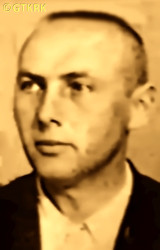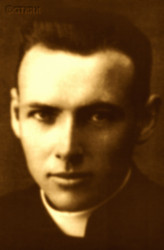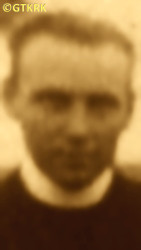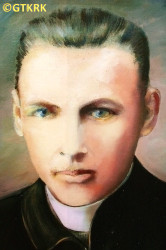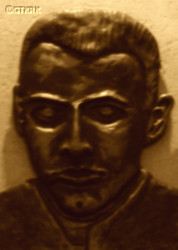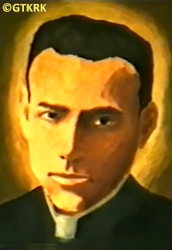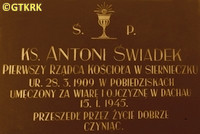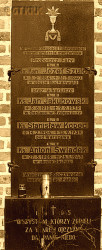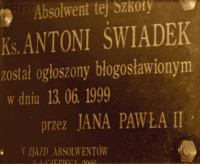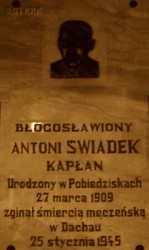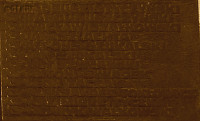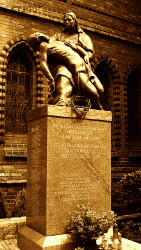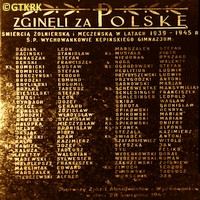Roman Catholic
St Sigismund parish
05-507 Słomczyn
85 Wiślana Str.
Konstancin deanery
Warsaw archdiocese, Poland
full list:
displayClick to display full list

searchClick to search full list by categories
wyświetlKliknij by wyświetlić pełną listę po polsku

szukajKliknij by przeszukać listę wg kategorii po polsku

Martyrology of the clergy — Poland
XX century (1914 – 1989)
personal data
religious status
blessed
surname
ŚWIADEK
forename(s)
Anthony (pl. Antoni)
beatification date
13.06.1999more on
www.swzygmunt.knc.pl
[access: 2013.05.19]

the RC Pope John Paul IImore on
en.wikipedia.org
[access: 2014.09.21]
function
diocesan priest
creed
Latin (Roman Catholic) Church RCmore on
en.wikipedia.org
[access: 2014.09.21]
diocese / province
Gniezno and Poznań archdiocese (aeque principaliter)more on
www.archpoznan.pl
[access: 2012.11.23]
RC Military Ordinariate of Polandmore on
en.wikipedia.org
[access: 2014.12.20]
date and place
of death
25.01.1945

KL Dachauconcentration camp
today: Dachau, Upper Bavaria reg., Bavaria state, Germany
more on
en.wikipedia.org
[access: 2016.05.30]
details of death
After German invasion of Poland on 01.09.1939 (Russians invaded Poland 17 days later) and start of the World War II, volunteered in became chaplain in one of the units of the Polish Army, prob. in „Pomerania” Army.
According to some sources accompanied it during whole September 1939 campaign.
After Polish defeat and start of German occupation, for a time ministered to Polish POWs in one of the POW camps, and next returned to his Bydgoszcz parish.
There in the summer of 1942 denounced by one of his parishioners for hearing confessions in Polish — also prepared Polish children for their First Holy Communion in Polish — and arrested by the Germans.
Jailed in Bydgoszcz prison.
Tortured and forced to do slave labour.
Finally on 07.10.1942 transported to KL Dachau concentration camp.
Suffered from typhoid fever (Lat. typhus abdominalis). Recovered.
At the end of 11.1944, an epidemic of typhus (Lat. typhus exanthematicus) broke out in the camp, associated with severe diarrhea in the patients. The sick were placed in a „revire” — a camp's hospital barrack — where the sick were left without help or medicine. Those who suffered the most the Germans murdered. The epidemic got out of control: on 05.12.1944, camp blocks No. 21 and 23 were isolated, on 16.12.1944 blocks No. 25 and 30. In 01.1945, the eastern side of the odd blocks from No. 19 to 29 was separated with barbed wire. „The plague spread by lice bites or by improper use of the typhus vaccine”. A witness recalled: „There were piles of prisoners' lice‐infested clothes strewn around the blocks. There were worms everywhere”. In 10.1944‐04.1945, 28,000 prisoners fell ill — 15,000 of them died.
Fell ill and on 08.01.1945, was transferred to such a „revire”.
Perished there after a few weeks.
prisoner camp's numbers
37193Click to display source page (KL DachauClick to display the description)
cause of death
extermination: exhaustion and starvation
perpetrators
Germans
sites and events
KL DachauClick to display the description, Bydgoszcz (prison)Click to display the description, Reichsgau Danzig‐WestpreußenClick to display the description, Ribbentrop‐MolotovClick to display the description, Pius XI's encyclicalsClick to display the description
date and place
of birth
27.03.1909

Pobiedziskatoday: Pobiedziska gm., Poznań pov., Greater Poland voiv., Poland
more on
en.wikipedia.org
[access: 2020.11.01]
parents
ŚWIADEK Vladislav
🞲 ?, ? — 🕆 ?, ?

MIELESZYŃSKA Vladislava
🞲 ?, ? — 🕆 ?, ?
baptism

Pobiedziskatoday: Pobiedziska gm., Poznań pov., Greater Poland voiv., Poland
more on
en.wikipedia.org
[access: 2020.11.01]
St Michael the Archangel RC church
presbyter (holy orders)
ordination
10.06.1933

Poznańtoday: Poznań city pov., Greater Poland voiv., Poland
more on
en.wikipedia.org
[access: 2021.07.18]
St Peter and St Paul the Apostles RC archcathedral churchmore on
en.wikipedia.org
[access: 2025.03.14]
positions held
1937 – 1942
curatus/rector/expositus — BydgoszczSiernieczek neighborhood
today: Bydgoszcz city pov., Kuyavia‐Pomerania voiv., Poland
more on
en.wikipedia.org
[access: 2021.06.20] ⋄ St George RC church ⋄ Bydgoszcztoday: Bydgoszcz city pov., Kuyavia‐Pomerania voiv., Poland
more on
en.wikipedia.org
[access: 2021.06.20], St Martin and St Nicholas the Bishops and Confessors RC parish (main parish) — also: builder of the rectory
1933 – 1937
vicar — Bydgoszcztoday: Bydgoszcz city pov., Kuyavia‐Pomerania voiv., Poland
more on
en.wikipedia.org
[access: 2021.06.20] ⋄ St Martin and St Nicholas the Bishops and Confessors RC parish (main parish) ⋄ Bydgoszcztoday: Bydgoszcz city pov., Kuyavia‐Pomerania voiv., Poland
more on
en.wikipedia.org
[access: 2021.06.20] RC deanery — also: chaplain of the local unit of Polish Scouting Association ZHP; also prob. support chaplain of local Polish Armed Forces garrison
1930 – 1933
student — Poznańtoday: Poznań city pov., Greater Poland voiv., Poland
more on
en.wikipedia.org
[access: 2021.07.18] ⋄ philosophy and theology, Archbishop's Theological Seminary (Collegium Leoninum)
1928 – 1930
student — Gnieznotoday: Gniezno urban gm., Gniezno pov., Greater Poland voiv., Poland
more on
en.wikipedia.org
[access: 2021.12.18] ⋄ philosophy, Archbishop's Theological Seminary
sites and events
descriptions
KL Dachau: KL Dachau in German Bavaria, set up in 1933, became the main German Germ. Konzentrationslager (Eng. concentration camp) KL for Catholic priests and religious during World War II: On c. 09.11.1940, Reichsführer‐SS Heinrich Himmler, head of the SS, Gestapo and German police, as a result of the Vatican's intervention, decided to transfer all clergymen detained in various concentration camps to KL Dachau camp. The first major transports took place on 08.12.1940. In KL Dachau Germans held approx. 3,000 priests, including 1,800 Poles. The priests were forced to slave labor in the Germ. „Die Plantage” — the largest herb garden in Europe, managed by the genocidal SS, consisting of many greenhouses, laboratory buildings and arable land, where experiments with new natural medicines were conducted — for many hours, without breaks, without protective clothing, no food. They slaved in construction, e.g. of camp's crematorium. In the barracks ruled hunger, freezing cold in the winter and suffocating heat during the summer, especially acute in 1941‐1942. Prisoners suffered from bouts of illnesses, including tuberculosis. Many were victims of murderous „medical experiments” — in 11.1942 c. 20 were given phlegmon injections; in 07.1942 to 05.1944 c. 120 were used by for malaria experiments. More than 750 Polish clerics where murdered by the Germans, some brought to TA Hartheim euthanasia centre set up in Schloss Hartheim in Austria and murdered in gas chambers. At its peak KL Dachau concentration camps’ system had nearly 100 slave labour sub‐camps located throughout southern Germany and Austria. There were c. 32,000 documented deaths at the camp, and thousands perished without a trace. C. 10,000 of the 30,000 inmates were found sick at the time of liberation, on 29.04.1945, by the USA troops… (more on: www.kz-gedenkstaette-dachau.deClick to attempt to display webpage
[access: 2013.08.10], en.wikipedia.orgClick to attempt to display webpage
[access: 2016.05.30])
Bydgoszcz (prison): Detention centre and court prison run by Germans. Those arrested in the detention centre were usually transported next to concentration cams. In 1945 the prison was evacuated — out 350 prisoners marched off from prison only 27 survived. (more on: www.sw.gov.plClick to attempt to display webpage
[access: 2013.10.05])
Reichsgau Danzig‐Westpreußen: After the Polish defeat in the 09.1939 campaign, which was the result of the Ribbentrop‐Molotov Pact and constituted the first stage of World War II, and the beginning of German occupation in part of Poland (in the other, eastern part of Poland, the Russian occupation began), the Germans divided the occupied Polish territory into five main regions (and a few smaller). The largest one was transformed into Germ. Generalgouvernement (Eng. General Governorate), intended exclusively for Poles and Jews and constituting part of the so‐called Germ. Großdeutschland (Eng. Greater Germany). Two were added to existing German provinces. From two other separate new provinces were created. Vistula Pomerania region was one of them, incorporated into Germany on 08.10.1939, by decree of the German leader Adolf Hitler (formally came into force on 26.10.1939), and on 02.11.1939 transformed into the Germ. Reichsgau Danzig‐Westpreußen (Eng. Reich District of Gdańsk‐West Prussia) province, in which the law of the German state was to apply. The main axis of the policy of the new province, the territory of which the Germans recognized as the Germ. „Ursprünglich Deutsche” (Eng. „natively German”), despite the fact that 85% of its inhabitants were Poles, was Germ. „Entpolonisierung” (Eng. „Depolonisation”), i.e. forced Germanization. C. 60,000 Poles were murdered in 1939‐1940, as part of the Germ. „Intelligenzaktion”, i.e. extermination of Polish intelligentsia and ruling classes, in c. 432 places of mass executions — including c. 220 Polish Catholic priests. The same number were sent to German concentration camps, from where few returned (over 300 priests were arrested, of whom c. 130 died in concentration camps). C. 124,000‐170,000 were displaced, including c. 90,000 to the Germ. Generalgouvernement. Poles were forced en masse to sign the German nationality list, the Germ. Deutsche Volksliste DVL. Polish children could only learn in German. It was forbidden to use the Polish language during Catholic Holy Masses and during confession. Polish landed estates were confiscated..To further reduce the number of the Polish population, Poles were sent to forced labor deep inside Germany. The remaining Poles were treated as low‐skilled labor, isolated from the Germans and strictly controlled — legally, three or three of them could only meet together, even in their own apartments. Many were conscripted into the German Wehrmacht army. After the end of hostilities of World War II, the overseer of this province, the Germ. Reichsstatthalter (Eng. Reich Governor) and the Germ. Gauleiter (Eng. district head) of the German National Socialist Party, Albert Maria Forster, was executed. (more on: en.wikipedia.orgClick to attempt to display webpage
[access: 2024.06.24])
Ribbentrop‐Molotov: Genocidal Russian‐German alliance pact between Russian leader Joseph Stalin and German leader Adolf Hitler signed on 23.08.1939 in Moscow by respective foreign ministers, Mr. Vyacheslav Molotov for Russia and Joachim von Ribbentrop for Germany. The pact sanctioned and was the direct cause of joint Russian and German invasion of Poland and the outbreak of the World War II in 09.1939. In a political sense, the pact was an attempt to restore the status quo ante before 1914, with one exception, namely the „commercial” exchange of the so‐called „Kingdom of Poland”, which in 1914 was part of the Russian Empire, fore Eastern Galicia (today's western Ukraine), in 1914 belonging to the Austro‐Hungarian Empire. Galicia, including Lviv, was to be taken over by the Russians, the „Kingdom of Poland” — under the name of the General Governorate — Germany. The resultant „war was one of the greatest calamities and dramas of humanity in history, for two atheistic and anti‐Christian ideologies — national and international socialism — rejected God and His fifth Decalogue commandment: Thou shall not kill!” (Abp Stanislav Gądecki, 01.09.2019). The decisions taken — backed up by the betrayal of the formal allies of Poland, France and Germany, which on 12.09.1939, at a joint conference in Abbeville, decided not to provide aid to attacked Poland and not to take military action against Germany (a clear breach of treaty obligations with Poland) — were on 28.09.1939 slightly altered and made more precise when a treaty on „German‐Russian boundaries and friendship” was agreed by the same murderous signatories. One of its findings was establishment of spheres of influence in Central and Eastern Europe and in consequence IV partition of Poland. In one of its secret annexes agreed, that: „the Signatories will not tolerate on its respective territories any Polish propaganda that affects the territory of the other Side. On their respective territories they will suppress all such propaganda and inform each other of the measures taken to accomplish it”. The agreements resulted in a series of meeting between two genocidal organization representing both sides — German Gestapo and Russian NKVD when coordination of efforts to exterminate Polish intelligentsia and Polish leading classes (in Germany called «Intelligenzaktion», in Russia took the form of Katyń massacres) where discussed. Resulted in deaths of hundreds of thousands of Polish intelligentsia, including thousands of priests presented here, and tens of millions of ordinary people,. The results of this Russian‐German pact lasted till 1989 and are still in evidence even today. (more on: en.wikipedia.orgClick to attempt to display webpage
[access: 2015.09.30])
Pius XI's encyclicals: Facing the creation of two totalitarian systems in Europe, which seemed to compete with each other, though there were more similarities than contradictions between them, Pope Pius XI issued in 03.1937 (within 5 days) two encyclicals. In the „Mit brennender Sorge” (Eng. „With Burning Concern”) published on 14.03.1938, condemned the national socialism prevailing in Germany. The Pope wrote: „Whoever, following the old Germanic‐pre‐Christian beliefs, puts various impersonal fate in the place of a personal God, denies the wisdom of God and Providence […], whoever exalts earthly values: race or nation, or state, or state system, representatives of state power or other fundamental values of human society, […] and makes them the highest standard of all values, including religious ones, and idolizes them, this one […] is far from true faith in God and from a worldview corresponding to such faith”. On 19.03.1937, published „Divini Redemptoris” (Eng. „Divine Redeemer”), in which criticized Russian communism, dialectical materialism and the class struggle theory. The Pope wrote: „Communism deprives man of freedom, and therefore the spiritual basis of all life norms. It deprives the human person of all his dignity and any moral support with which he could resist the onslaught of blind passions […] This is the new gospel that Bolshevik and godless communism preaches as a message of salvation and redemption of humanity”… Pius XI demanded that the established human law be subjected to the natural law of God , recommended the implementation of the ideal of a Christian state and society, and called on Catholics to resist. Two years later, National Socialist Germany and Communist Russia came together and started World War II. (more on: www.vatican.vaClick to attempt to display webpage
[access: 2023.05.28], www.vatican.vaClick to attempt to display webpage
[access: 2023.05.28])
sources
personal:
pl.wikipedia.orgClick to attempt to display webpage
[access: 2014.12.20], www.wtg-gniazdo.orgClick to attempt to display webpage
[access: 2012.11.23], photos.szukajwarchiwach.gov.plClick to attempt to display webpage
[access: 2025.03.07], www.ipgs.usClick to attempt to display webpage
[access: 2012.11.23]
original images:
www.youtube.comClick to attempt to display webpage
[access: 2024.12.13], www.archidiecezja.plClick to attempt to display webpage
[access: 2015.09.30], izbameczennikow.plClick to attempt to display webpage
[access: 2024.12.13], mbnppobiedziska.ns48.plClick to attempt to display webpage
[access: 2019.10.13], www.panipobiedzisk.plClick to attempt to display webpage
[access: 2015.09.30], www.youtube.comClick to attempt to display webpage
[access: 2024.12.13], parafiaswstanislawa.plClick to attempt to display webpage
[access: 2024.12.13], commons.wikimedia.orgClick to attempt to display webpage
[access: 2014.01.06], www.kepnosocjum.plClick to attempt to display webpage
[access: 2014.01.06], www.wtg-gniazdo.orgClick to attempt to display webpage
[access: 2012.11.23], www.szczecin.plClick to attempt to display webpage
[access: 2014.09.21], www.kepnosocjum.plClick to attempt to display webpage
[access: 2021.07.15]
LETTER to CUSTODIAN/ADMINISTRATOR
If you have an Email client on your communicator/computer — such as Mozilla Thunderbird, Windows Mail or Microsoft Outlook, described at WikipediaPatrz:
en.wikipedia.org, among others — try the link below, please:
LETTER to CUSTODIAN/ADMINISTRATORClick and try to call your own Email client
If however you do not run such a client or the above link is not active please send an email to the Custodian/Administrator using your account — in your customary email/correspondence engine — at the following address:

giving the following as the subject:
MARTYROLOGY: ŚWIADEK Anthony
To return to the biography press below:
 Click to return to biography
Click to return to biography








